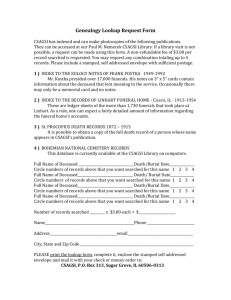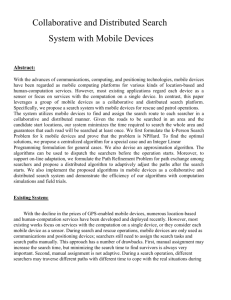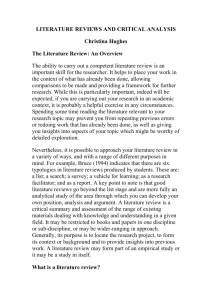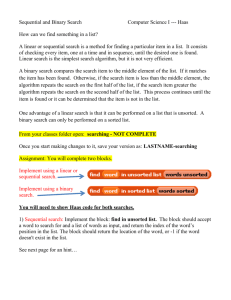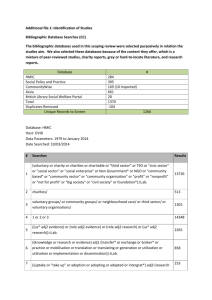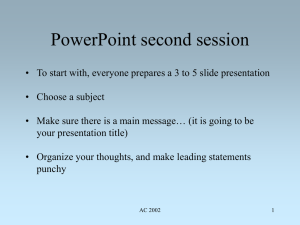Conduct Research
advertisement
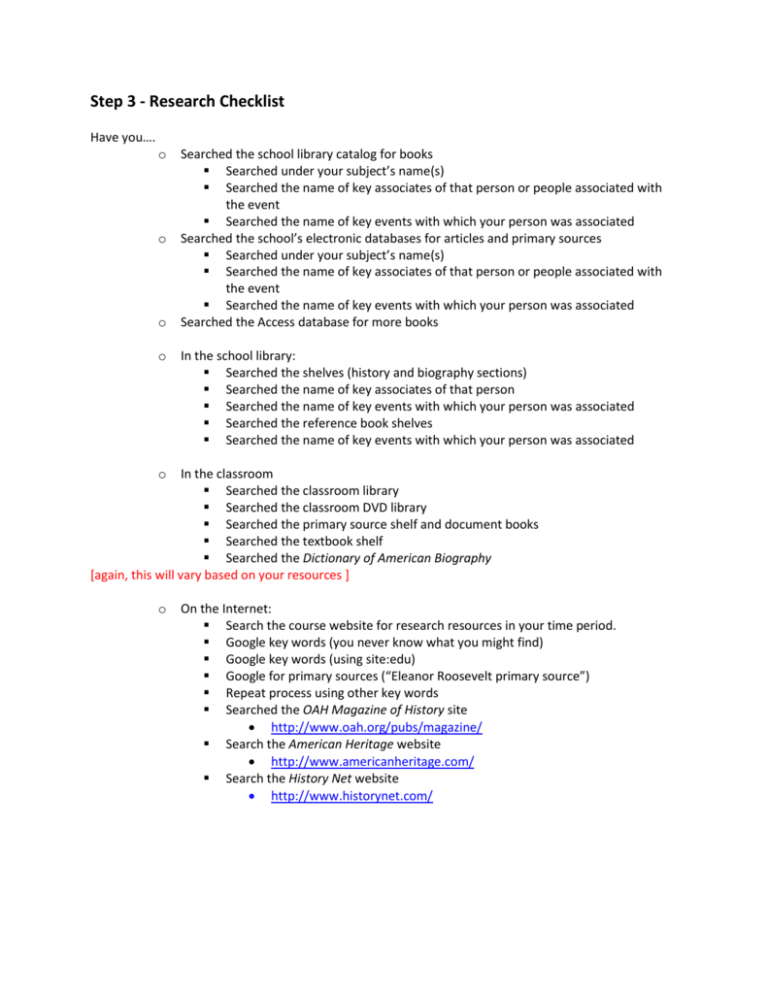
Step 3 - Research Checklist Have you…. o o o o Searched the school library catalog for books Searched under your subject’s name(s) Searched the name of key associates of that person or people associated with the event Searched the name of key events with which your person was associated Searched the school’s electronic databases for articles and primary sources Searched under your subject’s name(s) Searched the name of key associates of that person or people associated with the event Searched the name of key events with which your person was associated Searched the Access database for more books In the school library: Searched the shelves (history and biography sections) Searched the name of key associates of that person Searched the name of key events with which your person was associated Searched the reference book shelves Searched the name of key events with which your person was associated o In the classroom Searched the classroom library Searched the classroom DVD library Searched the primary source shelf and document books Searched the textbook shelf Searched the Dictionary of American Biography [again, this will vary based on your resources ] o On the Internet: Search the course website for research resources in your time period. Google key words (you never know what you might find) Google key words (using site:edu) Google for primary sources (“Eleanor Roosevelt primary source”) Repeat process using other key words Searched the OAH Magazine of History site http://www.oah.org/pubs/magazine/ Search the American Heritage website http://www.americanheritage.com/ Search the History Net website http://www.historynet.com/ Reminder about Primary, Secondary and Tertiary Sources Primary Source-The most common definition of a primary source is that which is written or produced in the time period. Primary sources are materials directly related to a topic by time or participation. These materials include letters, speeches, diaries, newspaper articles from the time, oral history interviews, documents, photographs, artifacts, or anything else that provides first-hand accounts about a person or event. This definition also applies to primary sources found on the internet. Secondary Source- Secondary sources are usually published books or articles by authors who were not eyewitnesses or participants in the historical event or period and who base their interpretation on primary sources, research, and study. These sources provide context for a historical event. For example, high school history textbooks, biographies, retrospective newspapers and other history books about a particular topic are secondary sources. This definition also applies to secondary sources found on the internet. Tertiary Source-Tertiary sources are summaries and collections of primary and secondary sources. These sources provide ideas for topics and further investigation. Some examples are almanacs, encyclopedias, dictionaries, guidebooks, manuals, etc. Keepers of the Past: Finding the Information You Need In the search for history and those little “nuggets” of information that provide historians with insight into the past, there are times when a lot of time and patience are needed to uncover (or discover!) just the right source. Listed below are “repositories”, or places where you might find many of the resources you need for your project! However, do not limit yourself to just this list! See if you can discover and record other repositories and sources of your own! STATE RECORDS: Historic Registers Photographs Census Records Geological Survey Maps Military Records Fire Records Railroad Records HISTORICAL & CULTURAL INSTITUTIONS: Special Collections Artifacts Archaeological Site Maps Letters Government Records Newspapers Exhibits Historical Archives COURTHOUSE: LIBRARY: SCHOOLS: Deeds Wills Ledgers Estate Settlements Marriage Records City Directories Tax Records Genealogy Records Census Records Business Ledgers Histories Reference Works Special Collections Primary Sources Magazines Books Photographs Yearbooks Attendance Records School Board Minutes HOME: Albums Diaries Journals Letters Private Collections Genealogy Quilts Oral Histories Medical Records Military Records Photographs ONLINE: BUSINESSES: PLACES OF WORSHIP: Primary Sources Secondary Sources Photographs Letters Census Records Genealogy Records Newspapers Employer Newsletters Correspondence Annual Reports Photographs Historical Records Memberships Names and Dates Cemetery Records Burial Practices Inscriptions Name: _____________________________________Date: ________________ National History Day Notes 1. TYPE OF SOURCE (circle one) Primary or Secondary 2. SOURCE INFORMATION: Title / Name of Source: ________________________________________________________________ Article Title (if needed) ________________________________________________________________ Type (book, interview, etc): ____________Volume/Edition (if needed)________ Author(s)/ Editor(s): ________________________________________________ Publisher: ________________________________________________________ City, State and Year Published: ________________________________________________________________ Pages Used: _____________________________________________________ FOR WEBSITES ONLY: URL: (www) ______________________________________________________ When it was electronically published: _________________Date Used: ________ 3. NOTES FROM THE SOURCE: Type of notes: (circle all that apply): Summary paraphrase and/or quotations Name: _____________________________________Date: ________________ Quotes (p.)from article/book Why quote is important National History Day Notes ______________________________________________________________________________ ______________________________________________________________________________ ______________________________________________________________________________ ______________________________________________________________________________ ______________________________________________________________________________ ______________________________________________________________________________ ______________________________________________________________________________ ______________________________________________________________________________ ______ 4. FOR ANNOTATION What is this source about? (Don’t just explain about your topic. What is included in this source?) Describe why it helps you with your topic/project. What does if bring to your research that helps you understand your topic/prove your thesis? 5. CITATIONS Now that you are finished with this part, go to one of these websites or use an MLA citations book to properly CITE the source. YOU ARE NOT DONE with this until you have PROPERLY cited the source!

